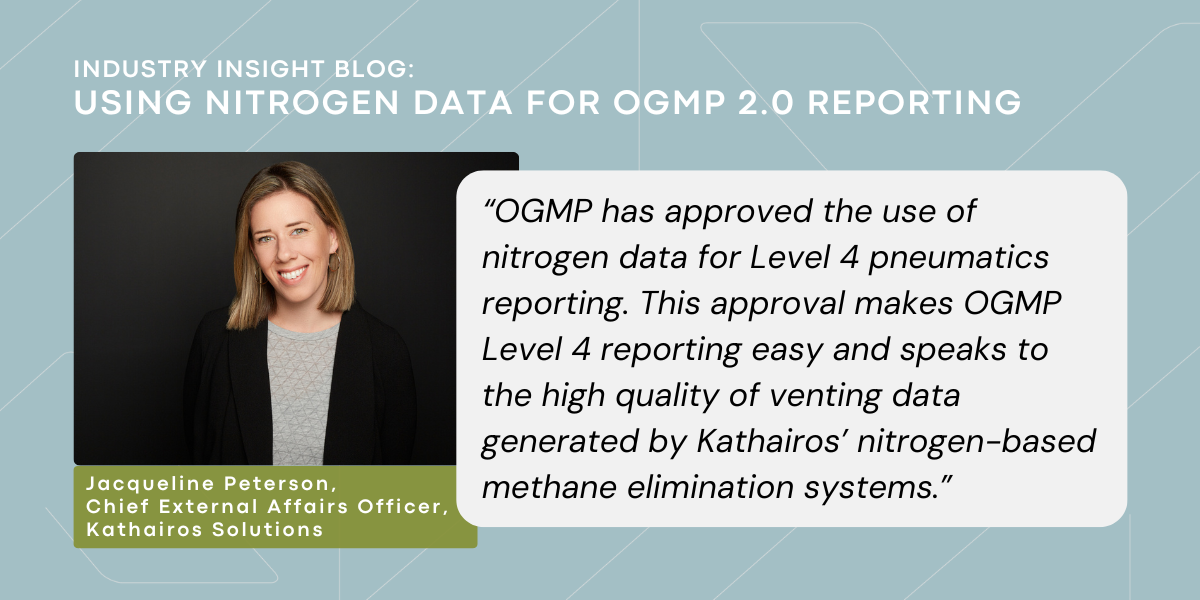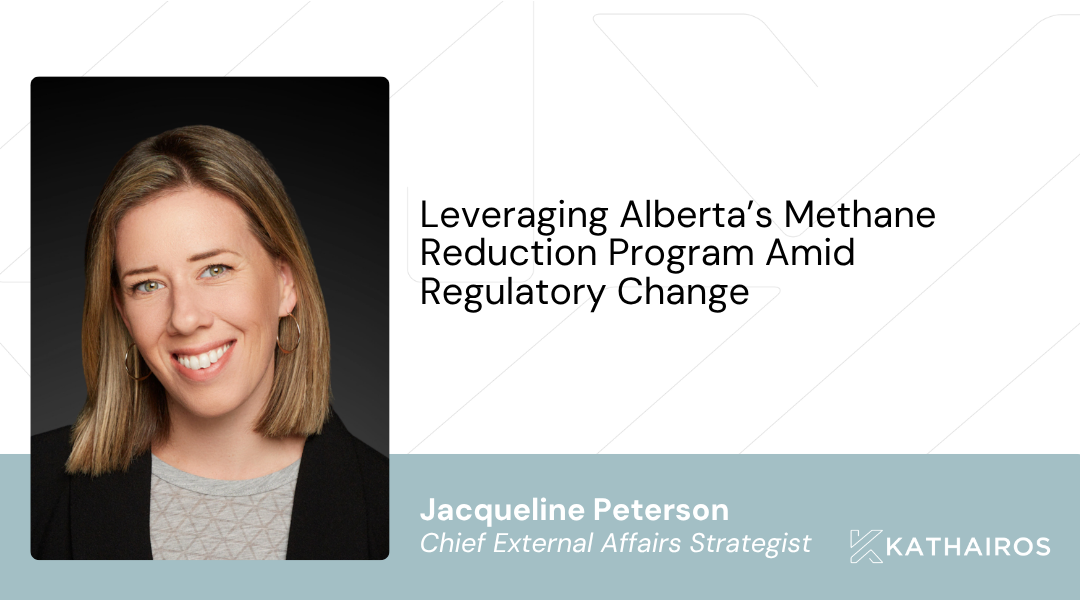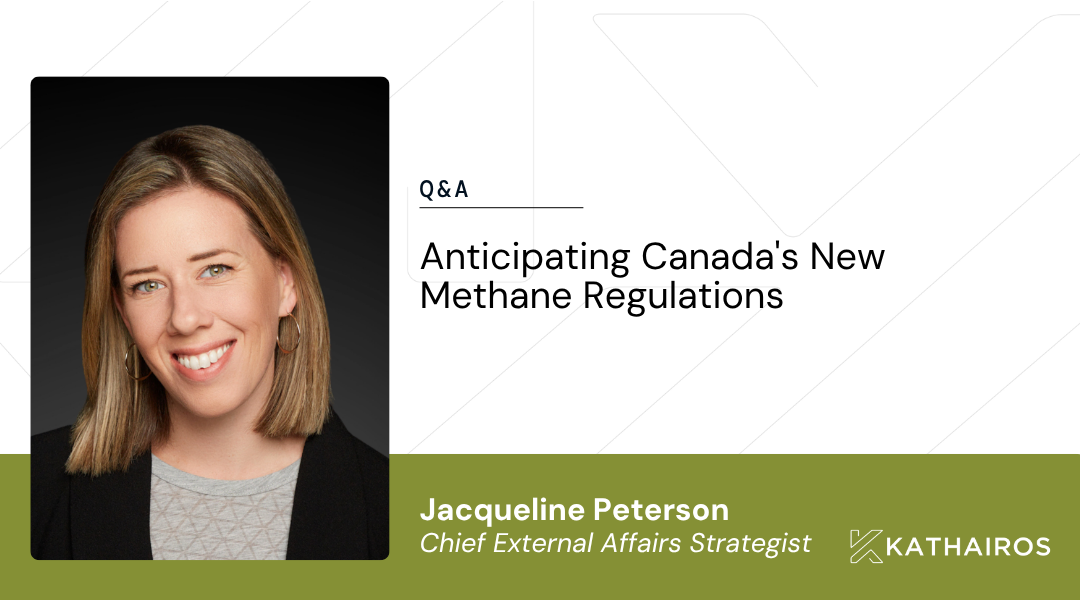
Kathairos has emerged as the leading North American solution for methane elimination from pneumatics, with more than 2,400 systems in operation across North America and over 70 major oil and gas producer partners.
In this post
Until recently, pneumatic vent rates have been tedious and challenging to report. Fortunately, the Oil and Gas Methane Partnership 2.0 (OGMP) has approved the use of nitrogen data for Level 4 pneumatics reporting. This approval makes OGMP Level 4 reporting easy and speaks to the high quality of venting data generated by Kathairos’ nitrogen-based methane elimination systems.
Background – The Challenges of Measuring Pneumatic Vent Rates
Pneumatic controllers and pumps are one of the largest sources of methane emissions from the oil and gas industry. There are hundreds of thousands of natural-gas driven process controllers operating across North America, each one emitting small volumes of methane gas every time they are actuated. These small volumes, at significant scale, are exactly why they are so difficult to measure. Previously, in order to measure pneumatic vent rates, an operator would need to direct an OGI camera (or something similar) at each pneumatic device for several minutes at a time. This process was further complicated by the sheer number of pneumatics operating, making the prospect of measuring pneumatic vent rates across a given region a daunting and time-consuming task for any operator. Additionally, pneumatic vent rates change over time with well site activity and temperature, meaning that a single “point in time” measurement is not always indicative of a device’s actual average vent rate. Given the difficulties in accurately measuring pneumatic emissions, we have little knowledge of the actual vent rates of these emission sources, despite pneumatic devices being so ubiquitous across the industry.
Why Nitrogen is the Best Way to Measure Pneumatic Venting
Kathairos eliminates methane emissions by using nitrogen as a replacement gas to power pneumatic devices, eliminating the need for pneumatic venting. Each facility is equipped with a liquid nitrogen tank, which stores nitrogen in liquid form. The nitrogen is then deployed (as a gas) at the same quantities and pressures as the methane (natural gas) that was previously used to power the devices. Nitrogen – a clean, inert gas – is then vented back into the atmosphere where it came from (nitrogen makes up 78% of the air we breathe).
In addition to eliminating all methane emissions, nitrogen is fantastic for understanding pneumatic vent rates and measuring what otherwise would have been emitted. Each nitrogen tank is equipped with level sensors that send hourly readings of the nitrogen used. Because it is a closed-loop system, every volume of nitrogen used corresponds to a volume of methane that otherwise would have been used. A gas equivalency ratio (GER) of 1.2764 is applied to recognize the (slightly) different densities of methane and nitrogen gas. Ultimately, nitrogen systems provide operators with continuous, real-time metrics of facility vent rates, methane mitigated and any changes in consumption that may indicate leaks.
How to Use Nitrogen Data for OGMP Reporting
In order to use nitrogen data for Level 4 OGMP reporting, operators will need to have up-to-date pneumatic inventories for all reporting facilities (those running on both nitrogen and natural gas). Upon receiving the pneumatic inventories for sites run on nitrogen, Kathairos pairs the nitrogen consumption data with the number of controllers operating at the facility, determining an average per-device (nitrogen) vent rate. The GER is then applied to determine the average per-device (methane) vent rate. The average per-device vent rate is then applied to the remaining natural-gas driven pneumatics owned by the operator for a measurement-informed pneumatic vent reporting across all assets.
The more facilities that are run by nitrogen, the greater the sample size and the more confident the operator can be in the representativeness of the results.
Using nitrogen for OGMP 2.0 reporting provides a dual benefit: decreasing methane emissions while making reporting easier and more accurate. It’s a win-win for all involved.
Next steps
Over the next several months, Kathairos will continue to work with with OGMP to formally integrate nitrogen-based measurements into OGMP 2.0’s Technical Guidance Documents. At the same time, we are also making changes to our digital platform, Atlas, to automate and further streamline the Level 4 pneumatics reporting process.
Finally, OGMP 2.0 is not the only organization that requires pneumatic vent reporting. We look forward to starting conversations with other regulatory/reporting bodies about the value and benefits of using nitrogen for reporting purposes. Good data benefits everyone.
Would using nitrogen data for OGMP 2.0 Level 4 reporting make things easier for you? Reach out, we always love to chat.
Explore more posts from Kathairos



%20For%20website.png)